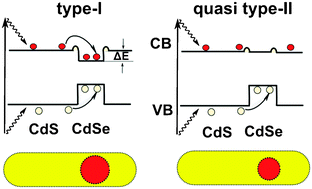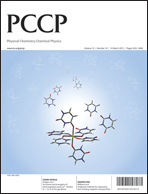We investigated systematically the temperature dependence of the spectral properties such as the band gap, bandwidth and fluorescence intensity of CdSe/CdS dot-in-rod nanocrystals. These asymmetry nanoparticles were synthesized by seeded growth techniques with band alignment of the type-I and quasi type-II with initial core sizes of 3.3 and 2.3 nm, respectively. With increasing temperature the band gap decreases and bandwidth increases, largely due to exciton–phonon scattering. Anomalous variations of the band gap and bandwidth were observed at 200–240 K, and the variations are attributed to the anisotropic strain in the CdSe/CdS interface due to temperature dependent lattice mismatch. The integrated intensity of fluorescence shows two variation regimes. In the low temperature regime, the intensity remained roughly constant due to the temperature dependent carrier mobility and trapping by the defect states in the CdS shell. However, in the higher temperature regime, the intensity decreased quickly due to thermal/phonon assisted escape from the CdSe dot. The barrier depths are estimated to be about 557 and 285 meV for type-I and quasi type-II samples, respectively.

You have access to this article
 Please wait while we load your content...
Something went wrong. Try again?
Please wait while we load your content...
Something went wrong. Try again?


 Please wait while we load your content...
Please wait while we load your content...